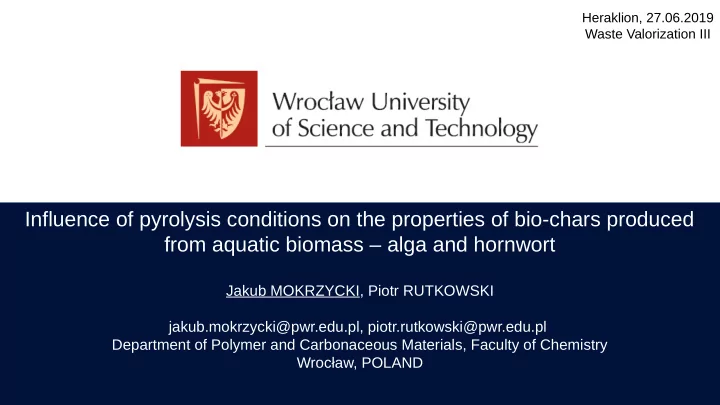

Heraklion, 27.06.2019 Waste Valorization III Influence of pyrolysis conditions on the properties of bio-chars produced from aquatic biomass – alga and hornwort Jakub MOKRZYCKI, Piotr RUTKOWSKI jakub.mokrzycki@pwr.edu.pl, piotr.rutkowski@pwr.edu.pl Department of Polymer and Carbonaceous Materials, Faculty of Chemistry Wrocław, POLAND
Hornwort and alga Alga ( Cladophora glomerata ) Hornwort ( Ceratophyllum demersum ) • fast growing abilieties • fast growing freshwater aquatic biomass • eutrophication of waters • high ability for nutrient acumulation • eutrophication of waters 2/12
Thermochemical conversion PROCESS PARAMETERS • inert atmosphere (20 dm 3 /h N 2 flow) • heating rate 10°C/min, residence time 1 hour • pyrolysis (500-800°C) 800°C 600°C 500°C FURNANCE N 2 400°C N 2 H 2 O 300°C volatile 250°C organics 25°C 3/12
Hornwort and alga – chemical composition characterization 50 • high amounts of ash (~20%) in both hornwort and Hornwort (H) 45 alga Alga (A) 41 40 • significant difference in cellulose and hemicellulose 40 contents 35 • over 3 fold higher amount of lignin in alga in 30 comparison to hornwort • higher extractives amount (20%) in hornwort than in 25 [%] alga (13%) 20 20 20 18 18 17 15 13 10 10 5 A. Ayeni, O. Adeeyo, O. Oresegun, T. Oladimeji, Compositional analysis of lignocellulosic 5 materials: Evaluation of an economically viable method suitable for woody and non-woody biomass, Am. J. Eng. Res. (2015). 0 Extractives Lignin Hemicellulose Cellulose Ash 4/12
Hornwort and alga – chemical composition characterization Solid yield after pyrolysis Mercury porosimetry 100 70,0 Total pore area Hornwort 1,200 (H) 90 Alga Total pore area 60,0 (A) Intrusion (H) 1,000 Total intrusion volume, cm3/g 80 75 Intrusion (A) 50,0 73 Total pore area, m2/g Bio-char yield, % 70 0,800 63 40,0 60 57 0,600 30,0 50 50 45 45 22,0 42 20,6 42 20,1 0,400 19,8 19,4 18,1 39 20,0 40 38 16,0 12,9 12,0 33 10,2 0,200 30 7,9 10,0 8,4 20 0,0 0,000 250 300 400 500 600 800 250 300 400 500 600 800 Temperature, °C Temperature, °C 5/12
Hornwort and alga characteristics SEM of 800°C bio-chars Proximate analysis pHpzc 70,0 14,0 Hornw Hornwort 13,2 ort 60,0 Alga 13,0 A250 Alga 12,4 Volatile matter (dry basis), % 50,0 12,0 A300 H250 11,2 11,1 10,8 40,0 11,0 10,4 pHpzc H300 A400 9,8 10,0 30,0 A500 9,2 A600 8,7 9,0 20,0 H400 8,1 7,8 H500 8,0 7,6 10,0 A800 H600 H800 7,0 0,0 250 300 400 500 600 800 20,0 25,0 30,0 35,0 40,0 45,0 50,0 55,0 60,0 Temperature, °C Ash (dry basis), % 6/12
Hornwort and alga characteristics FTIR Ultimate analysis C daf H daf O diff N daf S d Van Krevelen diagram Sample % % % % % 45.5 6.1 42.5 5.3 0.64 Hornwort 59.0 3.1 31.3 6.0 0.37 H500 60.9 2.3 30.9 5.2 0.42 H600 64.0 1.6 29.7 3.9 0.40 H800 38.8 5.9 49.3 4.0 1.62 Alga 55.2 2.8 31.9 5.0 2.97 A500 60.8 2.2 26.5 4.8 3.08 A600 73.3 2.2 12.2 4.2 3.49 A800 daf - dry ash-free basis, diff – calculated by difference, d – dry basis 7/12
„Single point” adsorption of dyes Phenol Methylene blue 100,0 14 100,0 14 Hor Hor 90,0 90,0 nwo nwo 13 13 rt rt 80,0 80,0 Alga Alga 12 12 70,0 70,0 60,0 60,0 % removed % removed solution pH solution pH 11 11 50,0 50,0 10 10 40,0 40,0 33,6 30,0 30,0 9 9 23,8 20,0 20,0 13,9 12,1 8 8 10,7 8,8 7,6 7,3 10,0 10,0 1,6 0,6 0,1 0,0 7 0,0 7 0,0 500 600 800 500 600 800 Temperature, °C Temperature, °C Initial concentration: 100 mg/dm 3 Initial concentration: 50 mg/dm 3 Initial solution pH value: 7.73 Initial solution pH value: 7.77 Mass of bio-char: 0.1 g Mass of bio-char: 0.1 g Solution volume: 100 cm 3 Solution volume: 100 cm 3 Sorption time: 24 h Sorption time: 24 h 8/12
„Single point” adsorption of herbicides Atrazine Isoproturon 100,0 14 100,0 14 Hor Hor 90,0 90,0 nwo nwo 13 13 rt rt 80,0 80,0 Alga Alga 12 12 70,0 70,0 60,0 60,0 % removed % removed solution pH solution pH 11 11 50,0 50,0 10 10 40,0 40,0 30,0 30,0 9 9 20,0 20,0 14,1 12,8 8 8 8,2 10,0 10,0 6,6 5,1 4,4 3,6 3,2 2,7 2,5 0,0 0,0 7 0,0 7 0,0 500 600 800 500 600 800 Temperature, °C Temperature, °C Initial concentration: 10 mg/dm 3 Initial concentration: 10 mg/dm 3 Initial solution pH value: 7.70 Initial solution pH value: 7.68 Mass of bio-char: 0.1 g Mass of bio-char: 0.1 g Solution volume: 100 cm 3 Solution volume: 100 cm 3 Sorption time: 24 h Sorption time: 24 h 9/12
„Single point” adsorption of heavy metal bio-char Cr 3+ 100,0 7 Hornwort Alga 0.1g 90,0 Hornwort Alga 6 80,0 5 70,0 60,0 % removed solution pH 4 50,0 3 40,0 Cr 3+ 28,8 30,0 EDTA 26,2 300mg/L 2 21,5 0.095g 20,0 1 24h 10,0 6,9 6,0 4,9 0,0 0 0 0 0 4cm 3 Temperature, °C Initial concentration: 300 mg/dm 3 10min Initial solution pH value: 4.61 Mass of bio-char: 0.1 g 80°C Solution volume: 100 cm 3 Sorption time: 24 h 10/12
Conclusions • high amounts of ash in bio-chars derived from aquatic biomass (up to 57%), is a result of presence of silica (from diatoms) and alkali metals oxides • alkali metals oxides presence results in high pHpzc values of obtained bio-chars (up to 13) • bio-chars were examined in „single point” adsorption of dyes: i ) phenol and methylene blue, ii ) herbicides: atrazine, isoproturon, iii ) heavy metal: Cr 3+ • significant coefficient between the pHpzc value and sorption capacity was observed 11/12
Thank you for your attention!
Recommend
More recommend